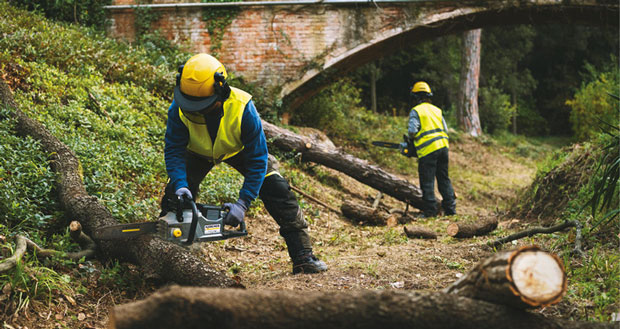Daniel Took, Head of Professional Marketing at Kärcher UK, shares best practice guidance on how estates teams can winter-proof their outdoor spaces section-by-section
With the clocks changing next month (October), signalling the bend of summer for another year, winter-proofing gardens and other outdoor spaces becomes top priority for UK-wide estates teams.
SECTION 1: LAWNS AND GRASSY AREAS
While the grass-cutting season may be rapidly drawing to a close, there’s still time to get one, or two, final cuts in. Given the fact the grass will be too wet and cold to mow for up to five months, making sure it’s around five to six centimetres tall will ensure it is nice and even and healthy when it does start growing again next spring.
Any loose leaves, small branches, twigs and moss and lawn cuttings should all be removed – not only will this help prevent the grass from decaying and becoming mouldy, it will make sure it gets maximum light exposure.
Finally, lawns and other grass areas should be given one last feed with a lawn fertiliser, which will provide all of the vital nutrients that are required to survive the winter.
Essential tools: Lawn mower (battery or cordless), leaf blower, rake, brush cutter, grass and shrub shear, grass trimmer.
SECTION 2: BUSHES, HEDGES AND TREES
For more established gardens and outdoor spaces, it’s not uncommon for there to be numerous established trees, as well as hedges and bushes throughout.
Regular maintenance, particularly heading into the winter when older branches are prone to breaking off in the wind, and the vast majority of hedges and bushes lose their leaves, exposing them to the elements, is essential. This involves making sure any diseased and dead sections have been removed and any longer branches, sections or sprouts are securely supported and/or fastened in place.
Hedges should be cut in a trapezoidal shape (narrow from the ground up). This allows light to shine on any ground level sprouts. It also means the hedges will retain their shape and won’t collapse under the weight of piles of snow.
Essential tools:Hedge trimmer, brush cutter, line trimmer, grass and shrub shears, grass trimmer, chain saw, tree lopper.
SECTION 3: FLOWER BEDS
Any plants with dead or wilting sections should be cut back, and any weeds should be removed. All annual flowers should also be removed, and any faded perennials cut down so they are around 5cm above the ground.
All borders need to be trimmed and shaped one last time. The beds should then be covered with a thick layer of compost, bark or well-rotted manure that will condition the soil, prevent it from being eroded away by sustained rainfall and protect roots from the frost when the temperatures start to plummet.
Flowering plants, such as pansies, cyclamen, heather and hellebores, are all capable of giving beds and containers a pop of colour that lasts all winter long.
Essential tools: Grass trimmer, cordless weed remover.
SECTION 4: GARDEN TOOLS
Garden tools, especially products that are battery-powered and feature the latest innovations, such as brushless motors, low noise and zero emissions technology, must be securely stored away to make sure they retain optimum functionality.
Any dirt should be wiped off, using a steel wool, wire brush or a high-pressure washer, depending on the level of dirt. Once used, pressure cleaners should be fully emptied and any hoses drained and rolled up without any kinks.
No gardening tools should be left outside during the winter. Rubber components can become porous when exposed to low temperatures, which can result in them becoming deformed. Meanwhile, any electronics in battery mowers, hedge trimmers and any other battery-operated tools are also at risk of becoming faulty and damaged if exposed to wet and cold weather.
Advice for winter-proofing high-pressure washers:Switch the high-pressure washers on without a water connection for approximately 30 seconds until it has run completely dry. If the device has a detergent tank, empty and rinse it out and store it away. Fill the tank with approximately 0.2 litres of fresh water to remove any residual cleaning chemicals before briefly switching the cleaner on in cleaning mode until the tank is empty.
Advice for storing battery-powered lawn mowers in the winter:They should ideally be locked away in a dry space at the end of October. The battery should be charged to around 75 per cent – as completely discharging lithium-ion batteries reduces their lifespan – and put in a place where the temperature is between 10 and 20°C. The actual lawn mower can be kept in outdoor storage facilities. But if the battery is permanently installed, the entire device should be stored in a dry place.
Winter is on its way and there are plenty of end-of-the-year jobs for estates teams to carry out over the coming weeks. Fortunately, thanks to the latest garden tool technology, the work can be carried out effectively and efficiently, regardless of the task at hand.





